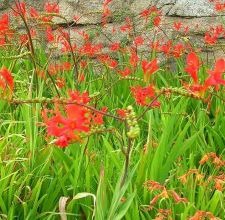Crocosmia Lucifer is a perennial evergreen deciduous flowering plant from the Iris family that grows from a bulb. Crocosmia blooms in July and August with fiery red, flame orange, apricot and yellow hues growing up to 6 feet in height. An excellent cut flower, it is also used as a specimen plant and planted en masse for dramatic effect. Crocosmia Lucifer thrives in sunny locales in rich, well-drained soil. In optimal conditions, the bulbs naturalize and multiply rapidly on their own. Crocosmia is hardy in zones 5 to 8 and needs heavy winter mulching everywhere else.
- Difficulty:
- Moderately Easy
Instructions
things you’ll need:
- Crocosmia bulbs or plants
- Hand trowel or shovel
- Clean, sharp hand pruners
- General purpose water soluble fertilizer
- Water
- Mulch
- Select a full sun location with rich, well-drained soil that can hold an average amount of moisture. Dig a hole at least twice the diameter of your plant’s root ball or bulb.
- Slide the mature Crocosmia out of its pot, loosening any circling roots and place down in the hold maintaining the established soil level on the plant even with the surrounding soil. If planting bulbs in the fall or spring, place the bulb in the soil approximately 6 inches down into the soil with the flattish root plate facing down into the soil. Back fill the soil around the bulb or root ball and press down gently with the palm of your hand.
- Water in your Crocosmia Lucifer well after planting, be it bulb or greened plant. If planting out a matured plant, monitor its water intake carefully over a few weeks to determine an ongoing watering regimen. You want consistently moist soil reaching 1 to 2 inches into the soil without being wet.
- Fertilize Crocosmia with a general-purpose water-soluble fertilizer twice a year, once in early spring and again in July during bloom. Apply the fertilizer in a circular area around the roots. Apply a 5-inch layer of organic mulch around and over the plant during the winter months where it does not over winter.
- Prune back the seed heads that form after flowering if you want to control the propagation of the plant. Otherwise, prune only as desired to control the size and shape or remove dead plant stems in areas where it does not over winter.


Deprecated: strpos(): Passing null to parameter #1 ($haystack) of type string is deprecated in /home/agriviek8Qv/agriviet.net/public_html/wp-includes/comment-template.php on line 2522